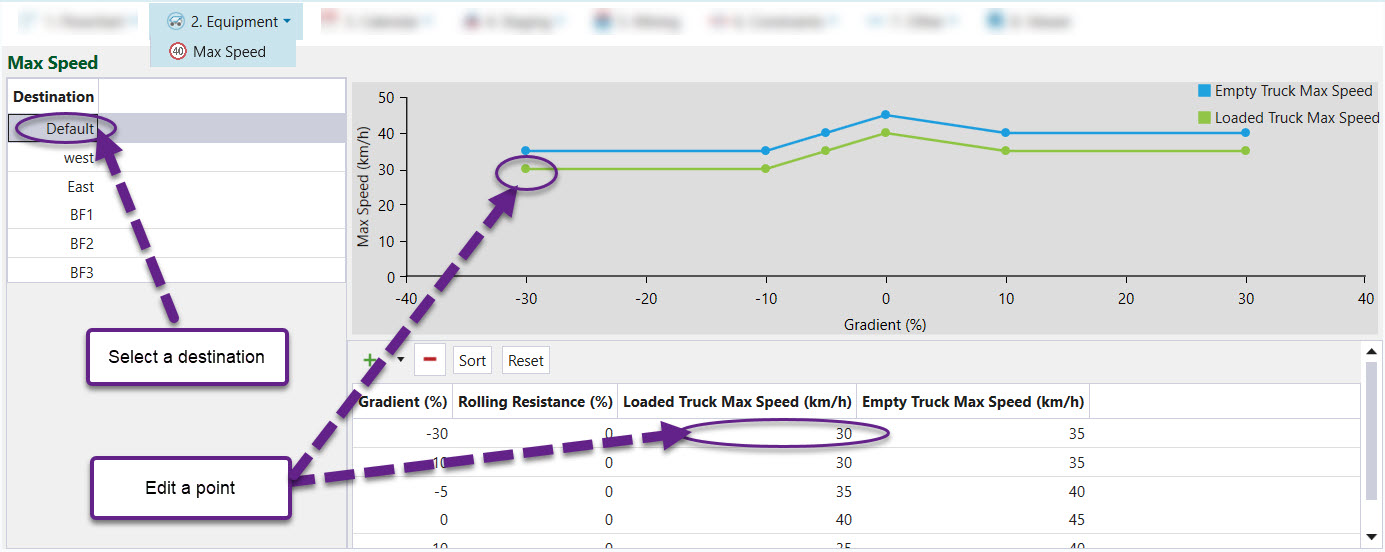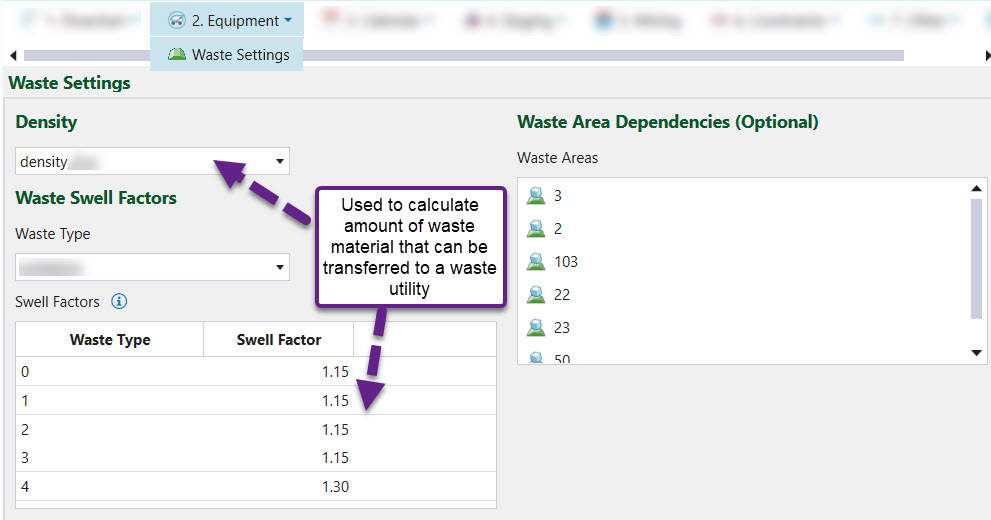Equipment
The following tabs are associated with the equipment objective:
- Truck Types
- Max Speed
- Equipment Code
- Equipment Code Specific Settings
- Equipment Code Truck Payloads
- Stockpile Trucks
- Waste Settings
- Hour Stamping
- Equipment Wait Time
- Advanced Options
- Calendar
Truck Types
The Truck Types tab is used to add trucks to the setup.

Max Speed
The Max Speed tab is used to set maximum loaded and unloaded truck speeds for each destination in the setup. The speeds correspond to road gradients which are also editable. This data is used to calculate haulage information.

Equipment Code
Available codes are added to the setup by choosing an item from the model dataset. They are used to represent different lithology types or stages. For each available code loaded, a productivity will be assigned per digger/truck combination in the Equipment Code Specific Settings and a truck payload will be calculated in the Equipment Code Truck Payloads tab.

Equipment Code Specific Settings
The Equipment Code Specific Settings tab is used to assign productivities per truck/digger combination for each available code. Note that available codes are loaded in the Equipment Code tab.
Equipment Code Truck Payloads
The Equipment Code Truck Payload tab automatically calculates the maximum tonnes that a truck can carry for each available code. Note that available codes are loaded in the Equipment Code tab. While the payload is calculated automatically, manual values can be provided by the user.
Stockpile Trucks
The Stockpile Trucks tab is used to confirm whether a truck is allowed to transfer material to a stockpile.

Waste Settings
The Waste Settings tab is used to calculate the volumetric expansion of wasted material when it is removed from the pit and sent to a waste utility. The degree of expansion depends on the waste type, which will have a specific swell factor provided by the user.

The volume of material transferred to a waste utility can be calculated using the following equation:
(1) V(m^3) = Waste type 1(V*SW) + Waste type 2(V*SW) +...+Waste type n(V*SW)
where SW represents swell factor.
When calculating tonnage, the density of material needs to be factored in:
(2) Mass (tonnes) = Density (tonnes/m3)*V
where the volume is calculated from Equation (1).
The tab also allows you to create dependencies between waste areas.
Hour Stamping
When a mining sequence is generated, the schedule information includes the rank of every solid mined, and the period it was mined in. Evolution allows this information to be added or stamped back to the model. By providing the period and the rank (optional), you are supplying a predetermined mining sequence. In such a scenario, server-side processing is performed for economical analysis or grade optimisation.
Equipment Wait Time
Equipment wait times are time frames required for the equipment to be set up.
- Loader spot time — Time for a truck to position itself under the digger.
- Load time — Time it takes for the digger to load the truck.
- Dump spot time — Time for a truck to position itself so that it can dump material.
- Dump time — The time it takes to dump material in a waste dump (typically 30 seconds).
- Queue time — The time it takes for a truck to wait for other trucks which are already loading/dumping.
Default times are back up values used in the case that the other values are either undefined or aren't available.
Advanced Options
The following parameters can be defined for Haulage based schedules:
Acceleration/Deceleration
Maximum Allowable Deceleration – Unloaded — This setting limits the deceleration of an empty truck to the specified number. This will override retard curve when necessary.
Maximum Allowable Deceleration – Loaded — This setting limits the deceleration of a loaded truck to the specified number. This will override retard curve when necessary.
Maximum Allowable Acceleration — This setting limits the acceleration of a truck. This will override the rimpull curve when necessary.
Traction
Coefficient of Traction — Factor describing the friction between truck tyres and ground.
Braking reliance on Traction — This factor proportionally increases distance required for breaking (represent reliance on traction coefficient to slow truck down).
Interpolated Path
Rolling Resistance — This factor specifies the rolling resistance from the current block that is mined to the start of the ramp.
Retarder Options
Maximum use of Retarder force — This setting helps to prevent overheating of the retarder on long steep descends. The lower this number the slower the truck will move when retarder is in use.
Use of Retarder — Currently Evolution defaults to “Always” and changing this setting does not impact calculations.
Miscellaneous
Travel Time Correction Factor — This factor can be used to account for any additional factors impacting travel time. A factor larger than 1 will increase travel time and vice versa.
Path Cost Factors
Costs can be assigned per hour (path time cost per hour) or per litre of fuel used (path fuel cost per litre).
Calendar
The following is a table of calculated fields in the Calendar > Equipment sub-tab.
| Field | Equation |
| Calendar Time (CT) |
|
| Lost Time (LT) | You provide this value. |
| Available Time (AT) |
|
| Availability (%) |
|
| Utilisation Factor (UF) | You provide this value. |
| Utilised Time (UT) |
|
| Utilisation |
|
| Operating Efficiency (OEF) | You provide this value. |
| Effective Utilisation (EU) |
|
| Total Haulage Hours (THH) |
|
| Seasonality Factor (SF) | You provide this value. |
| Seasonally Adjusted Haulage Hours (SHH) |
|
| Seasonally Adjusted Utilisation (SU) |
|
| Operating Time (OT) |
|
| Seasonally Adjusted Operating Time (SOT) |
|